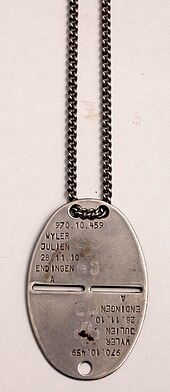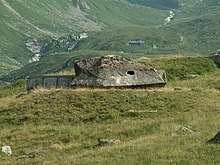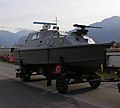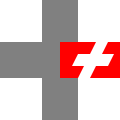Swiss Armed Forces
| Swiss Armed Forces | |
|---|---|
| |
| Related articles | |
| Ranks | Military ranks of Switzerland |
The Swiss Armed Forces (German: Schweizer Armee, French: Armée suisse, Italian: Esercito svizzero, Romansh: Armada svizra; lit. 'Swiss Army') operates on land and in the air, serving as the primary armed forces of Switzerland. Under the country's militia system, regular soldiers constitute a small part of the military and the rest are conscripts or volunteers aged 19 to 34 (in some cases up to 50). Because of Switzerland's long history of neutrality, the Swiss Armed Forces do not take part in conflicts in other countries, but do participate in international peacekeeping missions. Switzerland is part of the NATO Partnership for Peace programme.[4]
The regulations of the Swiss militia system stipulate that the soldiers keep their own personal equipment, including all personally assigned weapons, at home (until 2007 this also included ammunition
The reform "Army XXI" replaced the previous model "Army 95" and was adopted by popular vote in 2003, reducing manpower from 400,000 to about 200,000 personnel, with 120,000 receiving periodic military training and 80,000 reservists who have completed their total military training requirements.[7] A further reform effective in 2018 heralded the reduction of forces to 100,000 members.
History


The land component of the Swiss Armed Forces originated from the cantonal troops of the

The first complete
Paragraph 19 of the revised constitution of 1874 extended the definition of the federal army to every able-bodied male citizen, which would have swollen the size of the army, had it not been replaced by later revisions, from under 150,000 to more than 700,000, with population growth during the 20th century rising further to some 1.5 million,[citation needed] the second largest armed force per capita[how?] after the Israel Defense Forces.[citation needed]

Prior to the revised constitution, Jews in Switzerland were excluded from the army, with various exceptions and special conditions through the years. In 1808, the laws of mandatory military service were particularly strict for Jews, who, unlike Christians, could not opt to be replaced by a volunteer. During this time, Jews were not considered to be Swiss citizens. Following the introduction of Jewish corporations in 1813, they were given separate documentation for military enlistment. A special rule in 1816 demanded that the Jews should pay an equipment contribution of 1000 francs per year (400 francs in 1808). From 1852 onwards, Jews served in the army like other Swiss citizens, and the constitution of 1874 removed all remaining discriminatory measures.[8][9]
A major

In the 1960s and 1970s, the armed forces were organised according to the "Armee 61" structure. Horse mounted cavalry (specifically dragoons) were retained for combat roles until 1973, and were the last non-ceremonial horse cavalry in Europe, as were bicycle infantry battalions until 2001.[11]
Since 1989, there have been several attempts to curb military activity or even abolish the armed forces altogether. A notable referendum on the subject was held on 26 November 1989 and, although defeated, did see a significant percentage of the voters in favour of such an initiative.
In 1989, the status of the army as a national icon was shaken by a
In 2016, the Swiss Federal Assembly voted to further reduce the army from 140,000 men to 100,000 men, reducing the time of basic training from 21 weeks to 18, but also to increase the military budget by 2.4 billion Swiss francs.[14] In 2022, the Assembly voted to increase spending by 1.4 billion Swiss francs by 2030, or at least 1% of the country's GDP.[15] The government planned to spend up to 50 billion Swiss francs on defense through the early 2030s.[16] In 2024, the Armed Forces was projected to face significant funding shortfalls.[17]
Personnel
As of 1 March 2017, the Swiss Armed Forces consist of 120,496 people on active duty (in Switzerland called Angehöriger der Armee, shortly AdA, engl.: Member of the Armed Forces), of which 9,163 are professionals, with the rest being conscripts or volunteers.[18] Women, for whom military service is voluntary, numbered 929: less than 1% of the total, with over 25% thereof being officers.[18] The numbers had increased by 2021. Once in service, women have the same rights and duties as their male colleagues, and they can join all services, including combat units. Recruits in multi-lingual Switzerland are usually instructed in their native language, except that the small number of Romansh-speaking recruits are instructed in German.
In contrast to most other comparable armed forces, officers are generally not career regulars. Under the most recent army reform, all soldiers complete a full recruit school of 18 weeks.[19] During the initial 18-week training period, recruits may volunteer for consideration to continue with NCO training.[19] After the completion of NCO training, individuals are promoted to sergeant and integrated into platoons at recruit schools as squad leaders (Gruppenchefs, Chefs de Groupe, Capogruppi). Squad leaders support their platoon commanders for the 18-week duration of the recruit school, with the exception of those who volunteer for officer school—they leave after 7 weeks of service as squad leaders—while those who volunteer for higher NCO school leave after 12 weeks of service as squad leaders. Officer candidates complete a 15-week course to prepare them for their role as platoon leaders (Zugführer, Chef de section, Caposezione), which traditionally culminates in a march covering 100 kilometres (62 mi) in 24 hours. After promotion to lieutenant, platoon leaders return to their recruit schools, where they take charge of a recruit school platoon for 18 weeks.[19]
There were about 15,000 officers and 29,000 NCOs in the Swiss Armed Forces in 2021.[18] Those of higher rank serve for longer each year; a private may serve 365 days over 30 years, while a high-ranking officer may serve 2,000 days before retiring. Each promotion requires more time, which is known as "paying your rank". This describes the mechanism of a soldier fulfilling their rank's minimal service time after being promoted into said rank. Companies subsidize military training by continuing to pay their employees, who list their ranks and responsibilities on their résumés.[20]
In January 2023, the Swiss Armed Forces began integrating Muslim and Jewish chaplains into the service. The army's chaplaincy had only been open to Catholics and Protestants until then. New insignia have been created for military jackets: the Islamic crescent for Muslims and the Tablets of Stone for Jews.[21]
Conscription
Switzerland has mandatory military service for all able-bodied male
People determined unfit for service, where fitness is defined as "satisfying physical, intellectual and psychological requirements for military service or civil protection service and being capable of accomplishing these services without harming oneself or others",
Almost 20% of all conscripts were found unfit for military or civilian service in 2008; the rate is generally higher in urban cantons such as
On 22 September 2013, a
Structure since 2018


In peacetime, the Swiss Armed Forces are led by the
In times of crisis or war, the


Army
Under the "Armee 61" structure, the Army was organised into Field Army Corps 1, 2, and 4, and Mountain Army Corps 3. This structure was superseded by the "Armee 95" structure and thereafter the "Armee XXI" structure.
Since the Army XXI reform in 2004, the basic structure of the Army has been reorganised in the following units: infantry
Air Force


The Swiss Air Force has been traditionally a militia-based service, including its pilots, with an inventory of approximately 456 aircraft whose lengthy service lives (many for more than 30 years) overlapped several eras. However, beginning with its separation from the Army in 1996, the Air Force has been downsizing; it now has a strength of approximately 270 fixed- and rotary-wing aircraft, and is moving towards a smaller, more professional force.
The primary front-line air-defence fleet consists of 30
In 2017, the Swiss Hornet fleet reached the 100,000 flight hours milestone as well as 20 years of flight operations.
Previously, the Swiss Air Force did not maintain 24/7 operational readiness status in peacetime, owing to the limited budget and staff available. The Swiss Air Force worked on extending the operational times in 2016, aiming to be maintaining readiness for two armed jet fighters round-the-clock by 2020.[37] On 31 December 2020, the Swiss Air Force gained two operational fighter jets ready to scramble 24/7.[38][39]
The difficulty of defending Swiss airspace is illustrated by the mountainous character and the small size of the country; the maximum extension of Switzerland is 348 km, a distance that can be flown in a little over 20 minutes by commercial aircraft. Furthermore, Switzerland's policy of neutrality means that they are unlikely to be deployed elsewhere (except for training exercises).
Intelligence gathering

The Swiss military department maintains the
The Onyx system was launched in 2000 in order to monitor both civil and military communications, such as telephone, fax or Internet traffic carried by satellite. It was completed in late 2005 and currently consists of three interception sites, all based in Switzerland. In a way similar to Echelon, Onyx uses lists of keywords to filter the intercepted content for information of interest.
On 8 January 2006 the Swiss newspaper
Lakes flotilla
The maritime branch of the Army maintains a flotilla of military patrol boats to secure several sizeable lakes that span Switzerland's borders. These boats also serve in a search and rescue role.
During the Second World War Switzerland fielded the Type 41 class of patrol boats, armed with the 24 mm Type 41 anti-tank rifle—not a personal weapon at 74 kg (163 lb),[42] and later replaced by a 20mm auto-cannon—and machine guns. Nine units were commissioned between 1941 and 1944. These boats were upgraded in 1964, notably receiving radars, radios and modern armament, and were kept in service into the 1980s, the last being decommissioned in late 1983.[43]
The force utilises later the Aquarius-class (Patrouillenboot 80) riverine patrol boats, which are operated by Motorboat Company 10 of the Corps of Engineers and which patrol lakes Geneva, Lucerne, Lugano, Maggiore and Constance.[44]
In June 2019 Finnish shipbuilder Marine Alutech delivered the first four of 14 Patrouillenboot 16, the Patrouillenboot 80's successor, to the flotilla and these boats's manufacturer designation as Watercat 1250 Patrol;[45] all ships of this class will be named for astronomical objects.
-
The Spiez, a Type 41 patrol boat, on display at the Swiss Museum of Transport
-
Aquarius-class patrol boat, Type 80
-
Patrouillenboot 16-class patrol boat.
Roles
The prime role of the Swiss Armed Forces is homeland defence. Switzerland is not part of any multinational war-fighting structure, but selected armed forces members and units do take part in international missions.
Military and civil defence
After World War II, Switzerland began building homes with 40 cm-thick concrete ceilings that might survive

Thousands of tunnels, highways, railroads, and bridges are built with
However, a significant part of these fortifications was dismantled between the 1980s and during the "Army 95" reformation. The most important fortifications are located at
at Saint-Maurice has not been used by the army since the beginning of the 1990s. The east side (Savatan) is still in use.During the Cold War the military expected that any invasion would likely come from the northeast, as the Soviet Union associated the country with NATO despite its stated neutrality.
Peacekeeping overseas

Operating from a neutral country, Switzerland's Armed Forces do not take part in armed conflicts in other countries. However, over the years, the Swiss Armed Forces have been part of several peacekeeping missions around the world.
From 1996 to 2001, the Swiss Armed Forces were present in Bosnia and Herzegovina with headquarters in Sarajevo. Their mission, as part of the Swiss Peacekeeping Missions, was to provide logistic and medical support to the Organization for Security and Co-operation in Europe (OSCE), protection duties and humanitarian demining. The mission was named SHQSU, standing for Swiss Headquarters Support Unit to BiH. It was composed of 50 to 55 elite Swiss soldiers under contract for six to 12 months. None of the active soldiers were armed during the duration of the mission. The Swiss soldiers were recognised among the other armies present on the field by their distinctive yellow beret. The SHQSU is not the same as the more publicized Swisscoy, which is the Swiss Army Mission to Kosovo.
In its first military deployment since 1815, Switzerland deployed 31 soldiers to Afghanistan in 2003, and two Swiss officers had worked with German troops. Swiss forces were withdrawn in February 2008.[49]
Switzerland is part of the
Equipment
Logos
-
Old logo
-
Quadrilingual logo until 2023
-
Quadrilingual logo since 2023
-
German-language logo since 2023
-
French-language logo since 2023
-
Italian-language logo since 2023
See also
- Military ranks of the Swiss Armed Forces
- Swiss Guard
- National Redoubt (Switzerland)
- Militia System
- Civil protection in Switzerland
References
- ^ a b c d [1] Archived 19 December 2023 at the Wayback Machine "Office fédéral de la statistique" (in French). Retrieved 19 December 2023.
- ^ a b [2] Archived 20 January 2024 at the Wayback Machine "Eidgenössiches Departement für Verteidigung, Bevölkerungsschutz und Sport" (in German). Retrieved 27 February 2024.
- ^ The World Factbook – Switzerland Central Intelligence Agency, Retrieved 23 May 2020
- ^ Frontières entre police et armée Archived 18 October 2016 at the Wayback Machine, Cahier du GIPRI, n° 2, 2004
- ^ SwissInfo Soldiers can keep guns at home but not ammo Archived 2 October 2012 at the Wayback Machine Swissinfo
- ^ "Zwei Drittel der Rekruten diensttauglich". NZZ Online (in German). 11 March 2008. Retrieved 23 February 2009.
- ^ Armeezahlen www.vbs.admin.ch Archived 9 September 2009 at the Wayback Machine (German)
- ^ Weldler-Steinberg, Augusta (1966). Geschichte der Juden in der Schweiz: Vom 16. Jahrhundert bis nach der Emanzipation (in German). Schweizerischer Israelitischer Gemeindebund. pp. 166–168.
- ISBN 978-3-85616-847-6.
- ^ World War I–Preparation in German, French and Italian in the online Historical Dictionary of Switzerland.
- ^ Doole, Claire (11 May 2001). "End of road for Swiss army cyclists". BBC News. Archived from the original on 31 August 2017. Retrieved 5 February 2008.
- ^ "L'évolution de la politique de sécurité de la Suisse" (in French). NATO. Archived from the original on 13 May 2009. Retrieved 12 July 2009.
- ^ a b "Volksabstimmung vom 2. Dezember 2001" (in German). Federal Chancellery. Archived from the original on 15 August 2010. Retrieved 12 July 2009.
- Swissinfo. 7 March 2016. Archivedfrom the original on 11 April 2016. Retrieved 31 March 2016.
- ^ "Parliament approves boost in Swiss army spending". SWI swissinfo.ch. 2 June 2022. Retrieved 6 September 2023.
- ^ Benrath, Bastian (17 August 2023). "Swiss Army Wants to Ramp Up Spending on Growing Europe Threats". Bloomberg.com. Retrieved 18 January 2024.
- ^ "Media report: Swiss army to face big financial issues in coming years". SWI swissinfo.ch. 1 February 2024. Retrieved 5 February 2024.
- ^ a b c "Die Schweizer Armee in Zahlen" [The Swiss Armed Forces in Numbers] (in German). Federal Department of Defence, Civil Protection and Sports. Archived from the original on 5 February 2020. Retrieved 29 May 2019. Updated annually.
- ^ a b c "Le modèle d'instruction et de service de l'Armée suisse" (PDF). Swiss Armed Forces. Retrieved 10 December 2019.[permanent dead link]
- ^ a b c d McPhee, John (31 October 1983). "La Place de la Concorde Suisse-I". The New Yorker. p. 50. Archived from the original on 14 July 2014. Retrieved 22 July 2013.
- ^ RCH (10 January 2023). "L'Aumônerie de l'armée est désormais ouverte aux non-chrétiens". www.rtn.ch (in Swiss French). Retrieved 25 November 2023.
- Federal Department of Defence, Civil Protection and Sports. Archived from the originalon 2 May 2009. Retrieved 10 July 2009.
- ^ "Femmes dans l'armée" (in French). Federal Department of Defence, Civil Protection and Sports. Archived from the original on 2 May 2009. Retrieved 10 July 2009.
- ^ "Ziviler Ersatzdienst" (in French). Federal Department of Defence, Civil Protection and Sports. Archived from the original on 28 February 2008. Retrieved 10 July 2009.
- ^ "Définition de l'aptitude au service" (in French). Federal Department of Defence, Civil Protection and Sports. Archived from the original on 2 May 2009. Retrieved 10 July 2009.
- ^ "Ordonnance sur la taxe d'exemption de l'obligation de servir" (in French). Federal Authorities of the Swiss Confederation. Archived from the original on 14 November 2009. Retrieved 10 July 2009.
- ^ "Protection civile" (in French). Federal Department of Defence, Civil Protection and Sports. Archived from the original on 30 April 2009. Retrieved 10 July 2009.
- ^ "Les chiffres du recrutement en 2008" (in French). Federal Department of Defence, Civil Protection and Sports. Archived from the original on 24 July 2011. Retrieved 10 July 2009.
- ^ "Les Suisses de l'étranger" (in French). Federal Department of Defence, Civil Protection and Sports. Archived from the original on 25 April 2009. Retrieved 10 July 2009.
- ^ "Doubles-nationaux" (in French). Federal Department of Defence, Civil Protection and Sports. Archived from the original on 26 April 2009. Retrieved 10 July 2009.
- ^ Referendums on 22 September 2013 Archived 6 March 2014 at the Wayback Machine Swiss Parliament, 28 June 2013. Retrieved, 4 March 2014(in German)
- ^ "Swiss Armed Forces – Organisation and Structure". Swiss Armed Forces. Archived from the original on 25 September 2020. Retrieved 6 May 2020.
- ^ "Lieutenant General Aldo C. Schellenberg". Swiss Armed Forces. Archived from the original on 20 September 2020. Retrieved 6 May 2020.
- ^ "Verordnung über die Strukturen der Armee (VSA)" (PDF). admin.ch (in German). Der Bundesrat. 29 March 2017.
- ^ "Grandes unités" (in French). Federal Department of Defence, Civil Protection and Sports. Archived from the original on 2 May 2009. Retrieved 12 July 2009.
- ^ "Swiss Hornets reach 50,000 flight hours milestone". Military Aviation Publications. 24 October 2008. Archived from the original on 19 October 2008. Retrieved 14 July 2009.
- Swiss Federal Council. 1 December 2015. Archivedfrom the original on 16 August 2016. Retrieved 19 July 2016.
- ^ "Service de police aérienne 24 h sur 24". www.admin.ch. Retrieved 19 January 2024.
- ^ "Swiss Air Force finally on call around the clock". SWI swissinfo.ch. 30 December 2020. Retrieved 5 February 2024.
- S2CID 147436044.
- ^ "Investigations against SonntagsBlick". 1 October 2006. Archived from the original on 11 January 2006. Retrieved 21 November 2019.
- ^ Tom Murphy (17 September 2019). "The Swiss Army's First Mass Anti-Tank Rifle The Tankbüchse (Tb) 41 24mm". Small Arms Defense Journal. Archived from the original on 28 February 2022. Retrieved 28 February 2022.
- ^ Information note of Spiez at the Swiss Museum of Transport
- ^ "Lehrverband Genie/Rettung – Truppen". Swiss Land Forces. Archived from the original on 1 May 2009. Retrieved 19 July 2009.
- ^ "Swiss Navy tauft ihre neuen Kriegsschiffe" (in German). 20 Minuten. 17 June 2019. Archived from the original on 18 January 2020. Retrieved 3 January 2019.
- ^ a b c McPhee, John (7 November 1983). "La Place de la Concorde Suisse-II". The New Yorker. p. 55. Archived from the original on 9 November 2013. Retrieved 22 July 2013.
- swissinfo. 3 July 2009. Retrieved 13 July 2009.[permanent dead link]
- ^ Imogen Foulkes. Swiss still braced for nuclear war Archived 13 February 2007 at the Wayback Machine. BBC News, 10 February 2007.
- ^ "Switzerland ends military mission in Afghanistan". 23 February 2008.
- ^ "Swiss participation to the mission NNSC in Korea". Federal Department of Defence, Civil Protection and Sport. Archived from the original on 4 June 2016. Retrieved 12 July 2009.
- ^ "Swiss keep watch over fragile peace". swissinfo. 19 May 2003. Retrieved 12 July 2009.[permanent dead link]
- ^ "Photogallery: NNSC Korea". Photogallery Thomas Mäder. Archived from the original on 2 April 2009. Retrieved 12 July 2009.
Bibliography
- John McPhee, La Place de la Concorde Suisse, New York: Noonday Press (Farrar, Straus & Giroux), 1984.
- Field Army Corps 1, Sécurité au seuil du XXIe siècle: Histoire et vie du Corps d'Armee de Campagne 1, c.2000. ISBN 2-9700264-0-6.
- MILVOC, German-English Dictionary of military terms from the Swiss Armed Forces
External links
- vtg.admin.ch—Swiss Armed Forces – Official website Archived 29 October 2019 at the Wayback Machine
- armee.ch—Swiss Armed Forces – Official website
- Articles, books and media by Stephen P. Halbrook
- Clip 15 Minutes with the Swiss Armed Forces [3]
- Virginia International Tattoo: Swiss Army Central Band







